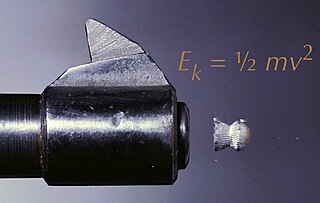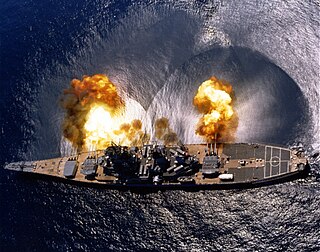
In physics, the kinetic energy of an object is the form of energy that it possesses due to its motion.

In Newtonian mechanics, momentum is the product of the mass and velocity of an object. It is a vector quantity, possessing a magnitude and a direction. If m is an object's mass and v is its velocity, then the object's momentum p is:

A kinetic energy penetrator (KEP), also known as long-rod penetrator (LRP), is a type of ammunition designed to penetrate vehicle armour using a flechette-like, high-sectional density projectile. Like a bullet or kinetic energy weapon, this type of ammunition does not contain explosive payloads and uses purely kinetic energy to penetrate the target. Modern KEP munitions are typically of the armour-piercing fin-stabilized discarding sabot (APFSDS) type.

The kinetic theory of gases is a simple classical model of the thermodynamic behavior of gases. It treats a gas as composed of numerous particles, too small to see with a microscope, which are constantly in random motion. Their collisions with each other and with the walls of their container are used to explain physical properties of the gas—for example, the relationship between its temperature, pressure, and volume. The particles are now known to be the atoms or molecules of the gas.

A bullet is a kinetic projectile, a component of firearm ammunition that is shot from a gun barrel. They are made of a variety of materials, such as copper, lead, steel, polymer, rubber and even wax; and are made in various shapes and constructions, including specialized functions such as hunting, target shooting, training, and combat. Bullets are often tapered, making them more aerodynamic. Bullet size is expressed by weight and diameter in both imperial and metric measurement systems. Bullets do not normally contain explosives but strike or damage the intended target by transferring kinetic energy upon impact and penetration.

Rifling is the term for helical grooves machined into the internal surface of a firearms's barrel for imparting a spin to a projectile to improve its aerodynamic stability and accuracy. It is also the term for creating such grooves.

A projectile is an object that is propelled by the application of an external force and then moves freely under the influence of gravity and air resistance. Although any objects in motion through space are projectiles, they are commonly found in warfare and sports.

Recoil is the rearward thrust generated when a gun is being discharged. In technical terms, the recoil is a result of conservation of momentum, as according to Newton's third law the force required to accelerate something will evoke an equal but opposite reactional force, which means the forward momentum gained by the projectile and exhaust gases (ejectae) will be mathematically balanced out by an equal and opposite momentum exerted back upon the gun.
Muzzle velocity is the speed of a projectile with respect to the muzzle at the moment it leaves the end of a gun's barrel. Firearm muzzle velocities range from approximately 120 m/s (390 ft/s) to 370 m/s (1,200 ft/s) in black powder muskets, to more than 1,200 m/s (3,900 ft/s) in modern rifles with high-velocity cartridges such as the .220 Swift and .204 Ruger, all the way to 1,700 m/s (5,600 ft/s) for tank guns firing kinetic energy penetrator ammunition. To simulate orbital debris impacts on spacecraft, NASA launches projectiles through light-gas guns at speeds up to 8,500 m/s (28,000 ft/s). FPS and MPH are the most common American measurements for bullets. Several factors, including the type of firearm, the cartridge, and the barrel length, determine the bullet's muzzle velocity.
In continuum mechanics, the Froude number is a dimensionless number defined as the ratio of the flow inertia to the external force field. The Froude number is based on the speed–length ratio which he defined as:
Internal ballistics, a subfield of ballistics, is the study of the propulsion of a projectile.

Muzzle energy is the kinetic energy of a bullet as it is expelled from the muzzle of a firearm. Without consideration of factors such as aerodynamics and gravity for the sake of comparison, muzzle energy is used as a rough indication of the destructive potential of a given firearm or cartridge. The heavier the bullet and especially the faster it moves, the higher its muzzle energy and the more damage it will do.
Stopping power is the ability of a weapon – typically a ranged weapon such as a firearm – to cause a target to be incapacitated or immobilized. Stopping power contrasts with lethality in that it pertains only to a weapon's ability to make the target cease action, regardless of whether or not death ultimately occurs. Which ammunition cartridges have the greatest stopping power is a much-debated topic.

The coefficient of restitution, is the ratio of the relative velocity of separation after collision to the relative velocity of approach before collision. It can aIso be defined as the square root of the ratio of the final kinetic energy to the initial kinetic energy. It normally ranges from 0 to 1 where 1 would be a perfectly elastic collision. A perfectly inelastic collision has a coefficient of 0, but a 0 value does not have to be perfectly inelastic. It is measured in the Leeb rebound hardness test, expressed as 1000 times the COR, but it is only a valid COR for the test, not as a universal COR for the material being tested.

A ballistic pendulum is a device for measuring a bullet's momentum, from which it is possible to calculate the velocity and kinetic energy. Ballistic pendulums have been largely rendered obsolete by modern chronographs, which allow direct measurement of the projectile velocity.

Airsoft pellets are spherical projectiles used by airsoft guns. Typically made of plastic, they usually measure around 6 mm (0.24 in) in diameter, and weigh 0.20–0.40 g (3.1–6.2 gr), with the most common weights being 0.20 g and 0.25 g, while 0.28 g, 0.30 g, 0.32 g and 0.40 g BBs are also commonplace. Though frequently referred to as "BBs" among airsoft users, these BBs are not the same as either of the 4.5 mm metal projectiles that BB guns fire, or the 4.6 mm (0.180 in)-sized birdshot from which the term "BB" originated.

In fluid dynamics, disk loading or disc loading is the average pressure change across an actuator disk, such as an airscrew. Airscrews with a relatively low disk loading are typically called rotors, including helicopter main rotors and tail rotors; propellers typically have a higher disk loading. The V-22 Osprey tiltrotor aircraft has a high disk loading relative to a helicopter in the hover mode, but a relatively low disk loading in fixed-wing mode compared to a turboprop aircraft.
Free recoil is a vernacular term or jargon for recoil energy of a firearm not supported from behind. Free recoil denotes the translational kinetic energy (Et) imparted to the shooter of a small arm when discharged and is expressed in joules (J), or foot-pound force (ft·lbf) for non-SI units of measure. More generally, the term refers to the recoil of a free-standing firearm, in contrast to a firearm securely bolted to or braced by a massive mount or wall. Free recoil should not be confused with recoil:

A muzzle blast is an explosive shockwave created at the muzzle of a firearm during shooting. Before a projectile leaves the gun barrel, it obturates the bore and "plugs up" the pressurized gaseous products of the propellant combustion behind it, essentially containing the gases within a closed system as a neutral element in the overall momentum of the system's physics. However, when the projectile exits the barrel, this functional seal is removed and the highly energetic bore gases are suddenly free to exit the muzzle and rapidly expand in the form of a supersonic shockwave, thus creating the muzzle blast.

Power factor (PF) in practical shooting competitions refers to a ranking system used to reward cartridges with more recoil. Power factor is a measure of the momentum of the bullet, which to some degree reflects the recoil impulse from the firearm onto the shooter.





















